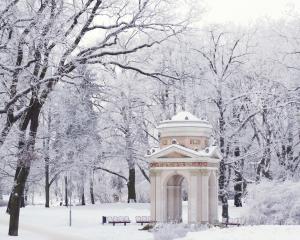
Arriving in Mantua, northern Italy, founded on the banks of the River Mincio about 2000BC, I explore its Unesco World Heritage historic centre. Within the old, red-brick city wall, I step back in time.
In river-stone paved Piazza Sordello, Mantua’s most ancient area, knights and legends are brought to mind seeing swallow-tailed battlements atop red-brick buildings. Indicating the city supported the emperor, they also top the 500-room Ducal Palace, built between the 14th and 18th centuries. Inside its walls I enjoy the serenity of a sculpted courtyard garden. Somewhere bells chime.
Piazza Erbe, once the market square, is surrounded by ancient brick and pastel buildings where shops below columned, covered arcades display local delights including cakes that appeared to have twirled spaghetti on top. Homes occupy floors above.

Its complicated face shows a 24-hour clock, phases of the moon and sun, and zodiacs which, linked to the seasons, were important to farmers when it was built in the 1600s. From the tower top, Mantua is a jumble of blackened terracotta roofs and jutting spires.
Beyond, the blue river is hemmed by greenery. Basilica di Sant’Andrea’s weathered, blue dome rises behind Piazza Erbe’s buildings. It’s my next stop.
Begun in 1472, the basilica was completed 400 years later. Its plain exterior belies the extravagant renaissance, baroque, romanesque and neo-classical architecture inside. Soaring ceilings and walls appear carved but are 3-D frescoes. Religious paintings decorate the dome; a balustrade octagon on the marble floor marks the crypt where two crystal and golden pots supposedly hold Christ’s blood.

On a barge and bike tour for seven nights, from Mantua eastwards to Venice, I cycle stretches of green countryside dotted with cornfields and quiet villages and alongside canals to arrive in Ferrara, another Unesco World Heritage medieval town.
In Italy’s Emilia-Romagna region, the town is thought to date from the 7th century. I half expect a trumpet to sound as I cross the aquamarine moat’s drawbridge into the 14th century red-bricked Este Castle. A square tower stands at each of its four corners. Stone cannon balls in the courtyard are perhaps Este family relics, rulers disliked by their citizens.
Exiting the castle, I wander a paved piazza to stand before the 12th century cathedral.
Its plain pinkish-grey block facade is made more eye-catching with three towering gables, and upper loggia and arches.

Windows have wooden shutters. Ornate, black iron braces protrude from walls supporting lanterns. Window boxes add greenery. In wider passages, narrow balconies overhang footpaths, iron grills cover windows and brass knockers decorate heavy wooden doors, wide and high ... maybe carriages once passed through their doorways. Rain means we miss walking along the top of the town’s 16th century wall.
Cycling the Valle da Pesca. passing cockle harvesting sheds, statue-like flamingo in the Po Delta and alongside the Adige River, we cross a bridge into Chioggia. Nicknamed Little Venice, it’s made up of artificial islands and founded around 2000BC. It’s older than Venice.
We cycle by Porta Garibaldi, the only remaining gate of the old walls, where a winged lion, Venice’s symbol, sits atop.
Bustling, wide, brick-paved Corso del Popolo is home to the red-brick, 17th century Cathedral di Santa Maria Assunta; a clock tower with a dome roof next to it and smaller, medieval churches among pink, mustard and brown, two and three-storey buildings with ground-level shops.
We park our bikes at Piazzetta Vigo, fronting the Venetian Lagoon, where another winged lion statue sits atop a high column.

I lose count of the arched, brick bridges crossing the canal as I wander alongside. From high windows, washing overhangs alleys running off it.
Once the Mediterranean’s salt capital, Chioggia also has an ancient fishing industry. Fishing boats return from the sea at 4am to deliver catches to the covered fish market.
At 10am, some stalls are already sold out, a huge selection still remains; scallops, mussels, crabs, prawns, octopus, squid, mackerel, mullet, cuttlefish, white flatfish and flatfish encrusted with what resemble black pinheads.
Having cycled narrow Pellestrina, home to fishermen and lacemakers, and Lido di Venezia, we meet the barge to cross the busy, choppy Venetian Lagoon.


Richly decorated, St Mark’s facade shows, in Murano glass, the story of two fisherman leaving the city in 828 for Egypt to steal St Mark’s bones and bring them to Venice.
They’re apparently within the basilica, begun in 1063 which contains 8000sqm of glass mosaics.
From the 100m-high bell tower I look down on to St Mark’s Square and its covered arcades and arched loggia. What history has played out down there over the centuries?
Two figures atop the 15th-century, fairy tale-like clock tower, featuring a winged lion and zodiac symbols, still ring its bell on the hour. Spires and domes interrupt terracotta rooftops, the 150 canals between indiscernible.

Water laps at lopsided, sinking, crumbling, plastered buildings, over doorsteps and at doors. Paint peels from wooden shutters; wrought iron rusts. It’s shabby. It’s picturesque.
On the fourth-floor rooftop terrace of luxury shopping mall T Fondaco dei Tedeschi, I look down on the Grand Canal busy with gondolas, vaporetto, sleek, wooden motorboats and a blue police boat.
It’s a wide, watery highway lined with Gothic, Renaissance and Baroque architecture; plain, pastel plastered buildings; ornately sculpted palaces. Church spires tower above.
I cross the shop-lined, 16th-century, marble and stone Rialto Bridge, the oldest bridge crossing the Grand Canal, then try to avoid wide, crowded alleys lined with expensive stores. I prefer back-alley Venice.

But I’m in no hurry to finish a journey that’s been like falling into a richly illustrated history book.
The writer travelled as a guest of UTracks on their eight-day Veneto Bike and Boat Premium tour.












